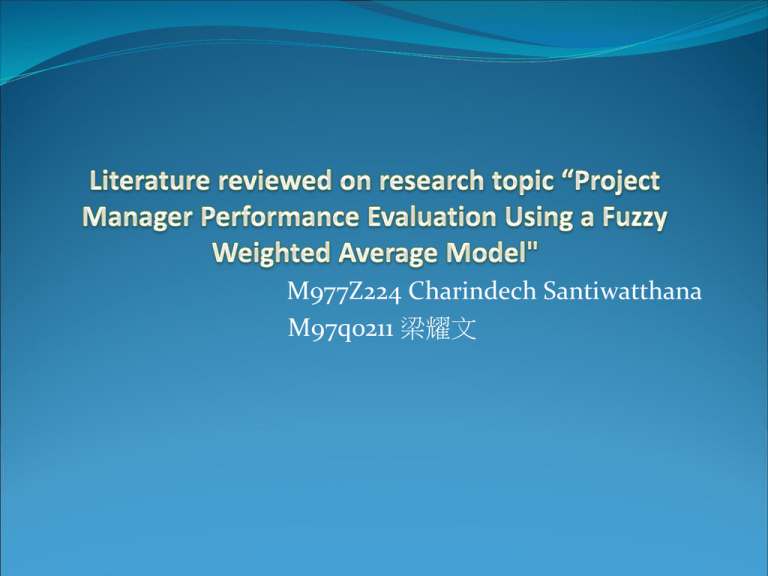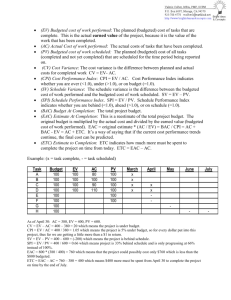M977Z224 Charindech Santiwatthana M97q0211 梁耀文
advertisement

M977Z224 Charindech Santiwatthana M97q0211 梁耀文 Literature Review Project and Project management A project is usually initiated with a specific need from the organization. Either satisfied result or unsatisfied, project will consume time, resource and man power. To gain the satisfied result, project requires some discipline, and that is project management. The project management is the business process of producing product service or to gain result over the specific time limited, it is accomplished through the application and integration of project management process of operation (i.e. initiating, planning, executing, monitoring and controlling, and closing) (Project Management Institute, 2004) Literature Review Project Success There exists significant number of organizations that have failed their projects by confusing the definition of “Project success” and “Project management success” (Cooke and Davies, 2002) . Normally, project success can be achieved when the project outcome fulfills somewhat of stakeholder expected, but project management can be succeeded by precisely controlling the cost, time and project goals. And there some times what stakeholder expected and the understanding of project goals from project manager perspective are not the same. Besides that, some other researches showed that the project failure may be caused by the insufficiently collaborative working relationship of the project (project manager, project team, methodology (process), and measurement system) (Standish Group, 2000). Literature Review Project Manager Specifically project manager is the critical role of the project, the responsible to plan, execute and manage the project with the defined budget and time under the uncertain environment. The previous literatures have shown some specific importance between project management and people who conducted the process, referring to the content of Chen and Yang (2009), managing people effectively can have a significant impact on the result of a project, and that makes the responsibility lie mainly with project manager. Project Manager Evaluation Traditionally, project manager is evaluated based on his/her project’s performance. But projects are different by its conditions and environments, it is still hard to tell who performs better than the others. Literature Review Financial Measures Cost, Schedule and Performance Measure Cost, schedule and performance measure is the most widely used measure for making project manager performance evaluation(Kerzner, 2004; Pinto and Slevin, 1988). Cost has been used when executing and evaluating the project Schedule can track the completion of required activities Performance measures the project outcome, normally measures against the desired outcome But many researchers suggested that the evaluations that use only cost, schedule and performance measures are too rough to describe project manager performance Literature Review Net Present Value Net present value (NPV) is a measure that considers both time and cost, using NPV allows inspector to speculate the value of the project in constant monetary unit. NPV is a legitimate measure (Blanchard, 1995; Pinder and Marucheck,1996). NPV can be effected by discount rate which is used to adjust the time series of benefits and cost for risk, time preferences of money and inflation, so the value changes from time to time (Swartz, 2008). Literature Review Earned Value Management System The earned value management system (EVMS) is a program management that is designed for effectively integrate the work scope of a program with the schedule and cost elements for optimum program planning and control. EVMS allows project controller to track the progress of the project. And also EVMS is widely accepted in performance measurement in both private and public sectors (Christensen,1994; Garrett, 2006). EVMS consists of several variables shown as table below; Table 2-1 Earned Value Management Variables EVMS variables Cost Variance The difference between the budgeted cost of work performed and the actual cost of work performed Cost Performance Index (CPI) The ratio of the budgeted cost of work performed over the actual cost of work performed. This CPI is a measure of efficiency and can be used to predict the final range cost. Schedule Variance The difference between budgeted cost of work scheduled and budgeted cost of work performed Schedule Performance Index (SPI) The ratio of budgeted cost of work schedule over cost of work performed. A productivity measure that can be useful in assessing how much work has been accomplished Budget at Completion (BAC) The sum of all budget values that have been previously established for the work to be performed on a project Estimate at Completion(EAC) The expected total cost of a particular schedule activity Variance at Completion (VAC) The difference between the Budget at Completion (BAC) and the Estimate at Completion (EAC) is VAC = BAC - EAC Literature review Non-Financial Performance Measures Balanced Score Card Balanced score card (BSC) is a popular non-financial measure for using in business purpose activity, that is introduced by the famous persons Kaplan and Norton (1992,1993,1996a, b) Basically, BSC was developed to implement the organization’s long-term strategy into the more short-term action by considering the top-manager perspective to the performance measure (Jazayen and Scapens, 2008). BSC is very useful to reflex the organization performance, and because of its range of use, BSC has been adopted into many modern sophisticated management techniques (Jazayen and Scapens, 2008) but because of it means different thing for different perspective, so it’s hard to adopt in the evaluation model that aims for general purpose. Literature review Leadership Behavior and Managerial Practice There are several literatures which mention that leadership behavior has a significant importance weight on the project success. Müller and Turnner (2006) proposed the research paper about the importance on matching leadership style of project manager and the project type. They suggested that project success also receives the influence from the compatibility of project manager’s leadership style and organization nature (i.e. working practice, culture, structure). In 2007 Chen and Lee proposed the model for evaluating the performance of managerial practice based on how project manager can elaborate 14 managerial practices of leadership behavior. The author also suggested that when making evaluation on managerial practice, the inspector should consider 4 proposed factors. Table 2-2 4 Clusters of 14 Leadership Behaviors Making decision Planning/ organizing Problem solving Consulting Delegating 14 Leadership behaviors Influencing people Building relationship Motivating/inspiring Recognizing Rewarding Networking Conflict Management/team Building Supporting Developing Givingseeking information Monitoring Informing Clarifying Table 2-3 4 Influence Factors For Evaluating Managerial Practice 4 Influence factors Technical This factor includes the familiarity of project management tools competence used, quality of employee, on-job training, and experiences learnt from previous successes or failures, which affect the performance of subsequent projects undertaken Enterprise The organization structure of enterprise will affect the performance organization of specific projects. Generally, the enterprise organization can be presented as functional, functional matrix , project matrix, and project team type of organization Project The properties include project typed, duration, amount of contracts, properties consignor, manpower and budget involved, and the relation to other project that have be finished Position level What kinds of resources can be used, what kind of people are responsible for negotiation, and what commanding and dispatching channels can be applied are all related to the position level of the project manager of the company Literature review Project Stability In 2008, Swartz proposed an idea on evaluation project manager performance. The contents of the paper indicate that project management’s stability is also capable of reflexing project manager management skill. The stability of the project refers to how resistant to disruption (stable) or sensitive to disruption (unstable) under the uncertainty of activities and resources. If the project is managed well, the project should be stable and it should reflex in terms of well scheduling management. The proposed model consists of two distinct groups: the offset measurement and the deviation measures. Literature Review Criteria Selection In this proposed model, project manager performance will be evaluated with current project performance and the managerial practice by using fuzzy decision making based approach to calculate and rank the performance of the project manager. The criteria are selected for the best interpretation, the criteria can be shown as below: Table 2-4 Selected Criteria Quantitative Qualitative Criterion Performance (Swartz, 2008) How much desirable features does the project successfully deliver Benefit Influencing people (Chen and Lee,2007) Motivating/inspiring, Recognizing, Rewarding Benefit Making decision (Chen and Lee,2007) Planning/ organizing, Problem solving, Consulting, Delegating Benefit Building relationship (Chen and Lee,2007) Networking, Conflict, Management/team, Building, Supporting, Developing Benefit Giving-Seeking information (Chen and Lee,2007) Monitoring, Informing, Clarifying Benefit Resource offset (Swartz, 2008) How much time resource spend waiting to work or catching up on work in terms of schedule activities (days) Cost Activity deviation (Swartz, 2008) Sum of day early or days late for all tasks AD=Days late –Days early (days) Cost Cost performance index (CPI) (Swartz, 2008) schedule performance index (SPI) (Swartz, 2008) The purposes of determining/measuring the actual cost efficiency of a project CPI=BCWP/ACWP The Schedule Performance Index is a measure of project efficiency and progress. SPI=BCWP/BCWS Benefit Benefit



